| More
Machines The mid 1960s was a time when the British motorbike industry was in
decline due to competition from the abundance of high quality foreign
machines. Many schemes were hatched to build a world-beating racing
machine to put British machines back in the forefront. In August 1965
DMW came up with such a machine called the ‘Typhoon’.
|
|
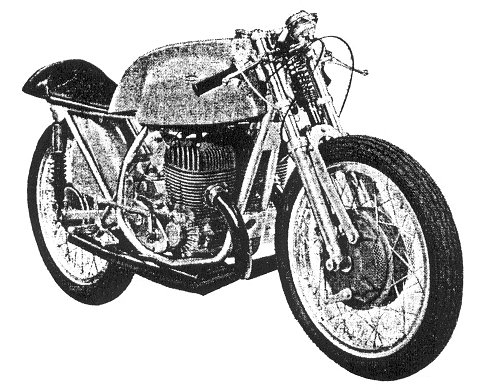
The DMW 'Typhoon' |
It was basically a pair of 250c.c. engines mounted in a modified
‘Hornet’ frame, with ‘Hornet’ parts used wherever possible.
Two machines were built, one using Villiers ‘Starmaker’ barrels and
heads, the other using Royal Enfield barrels and heads.
The two engines
had coupled crankshafts via an idler gear.
This drove a jackshaft to the
clutch, which required the engine to run backwards.
|
| Specification: |
|
|
| Machine 1: |
Engine: |
494c.c. 2 stroke, Villiers ‘Starmaker’ barrels
and heads. 68mm bore x 68mm stroke |
|
Carburettors: |
38mm Amal MkII |
|
Gearbox: |
Albion 5 speed |
|
Transmission: |
Longitudinal drive gear chain to the clutch |
|
Clutch: |
DMW |
|
Forks: |
DMW with external damper |
|
Chassis:
|
Modified 250c.c. ‘Hornet’ frame, square section swinging arm |
|
Brakes: |
Front– Yamaha TD2 4LS Rear– Yamaha
TD2 1LS |
|
|
|
| Machine 2: |
Engine: |
494c.c. 2 stroke, Royal Enfield GP barrels and heads. 66mm
bore x 72mm stroke |
|
Carburettors: |
1.5inch GPs |
|
Gearbox: |
Albion 5 speed |
|
Transmission: |
Longitudinal drive gear chain to the clutch |
|
Clutch: |
DMW |
|
Forks: |
DMW with external damper |
|
Chassis: |
Modified 250c.c. ‘Hornet’ frame, square section swinging arm
|
|
Brakes: |
Front – 8.5inch Oldani
Rear – 6inch DMW |
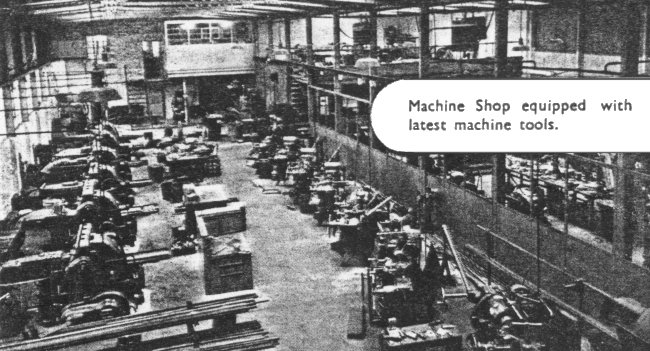
The Machine Shop from the 1952 catalogue.
Courtesy of Jo Skidmore.
| The machines were capable of at least 60b.h.p. at 6,000r.p.m. and
could reach speeds of 130m.p.h. at 8,000r.p.m. in 4th gear.
They were nicely finished off with a fibreglass seat and tank by Bill
Jakeman. DMW was hailed in the press as a saviour of national pride and
as the expected output power was 70b.h.p. from a machine weighing only
287lb, it would be a winner from the start. Harold Nock however said
that the machine would only be raced when it was thoroughly tested and
proven. Testing was carried out by Bill Smith and Jack Findley at
Silverstone. Only the ‘Starmaker’ version was tested.
Unfortunately the machine vibrated badly and the brakes
were not effective. Oil leaking from the central drive
caused ignition problems because it ran onto the points.
|
| Although the problems could easily have
been rectified, the project was shelved, even though the
machines had a lot of potential.
The second machine was only used for display at shows.
The ‘Starmaker’ machine was sold
to Roy Martin in 1985 and has since raced on many occasions.
The
other machine was presented to the National Motorcycle Museum by
Metal Profiles later owners; Ivan Dyke and Graham Beddall. |
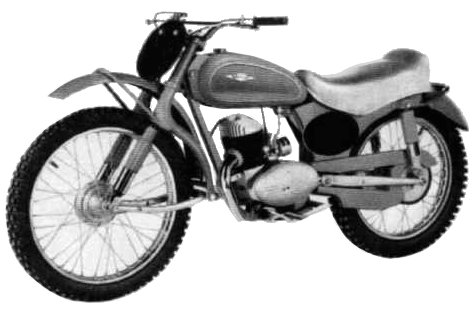
The Moto-Cross Mark 5 which was powered by
a Villiers 200c.c. 7E engine. |
| The original 'Hornet', which first appeared in 1954 was
extensively redesigned to produce a new version. The prototype was
running in early 1963 and went on sale in 1964. The machine, powered
by a Villiers 'Starmaker' 247c.c. two stroke engine, first
appeared
in 1962 and was later redesigned to increase the power output from
25b.h.p. at 7,000r.p.m. to 32b.h.p. at 7,400r.p.m. It ran very smoothly
with little vibration. |
|
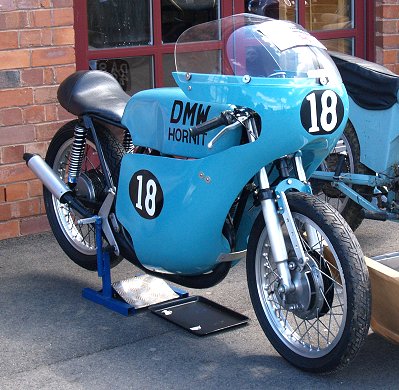
Gemma Toon's 1964 'Hornet'. |
The new 'Hornet' had three powerful
brakes, two at the front, on each side of the hub, and one at the
back. Other features included a Girling gas and hydraulic steering
damper, and a Villiers 4 speed gearbox.
The frame was a duplex-tube cradle type
with a taper-roller bearing steering head. The machine was nicely
finished with a Jakeman racing fairing, and sold for £365.
In 1964 Bill Smith rode the works machine in the Isle of Man
Southern 100, and finished in first place.
The 'Hornet' Mk2 appeared in 1966, powered by a hybrid engine consisting of an
Alpha crankshaft, DMW crankcase, and Royal Enfield cylinder.
It was very
successful in trials and came in third place in the Isle of Man Southern
100, ridden by Brian Duffy. |
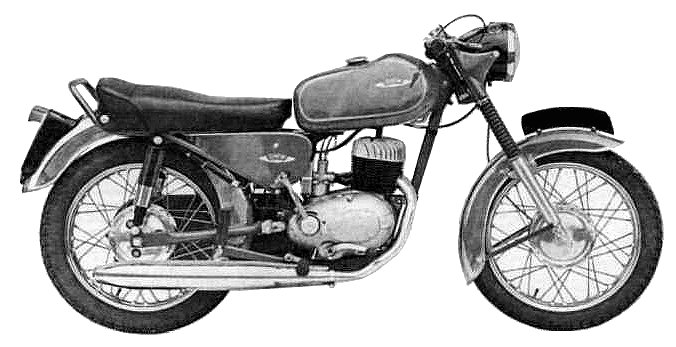
The 249c.c. 'Sports Twin from 1965.
| The 'Dolomite' Mk2 appeared in 1962, powered by a
250cc Villiers engine, and was soon renamed the DMW 'Sports Twin'. The
engine, the 249c.c. two-stroke Villiers Mark 4T had cast iron cylinder barrels,
with a crankshaft supported in one ball, and two roller big end bearings. It was
fitted with a Villiers S25 carburettor, a Villiers 6 pole flywheel
generator with remote ignition coils, a 4 speed Villiers gear box
with multi-plate clutch, and 6inch diameter DMW-Girling brakes at
the front and rear. The machine also had Metal Profiles
telescopic front forks, pivoted rear forks, and Girling spring
and hydraulic rear suspension units. There was a 7inch Lucas
headlamp, a 52inch wheelbase, and a ground clearance of 5.25
inches. The machine weighed 307lb with approximately half a gallon of
fuel. The fuel consumption was 102m.p.g. at 30m.p.h. and a top
speed of 69m.p.h. It was smartly finished in Italian
red, with a gold-lined fuel tank, polished light-alloy
fork legs,
and chromium-plated mudguards. It sold for £222.15s.0d. |
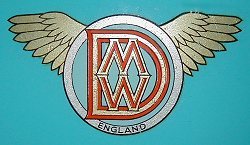
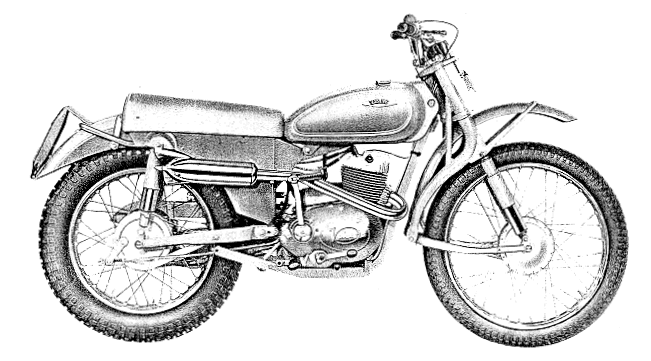
DMW 250 cc Mark 10 Trials Model.
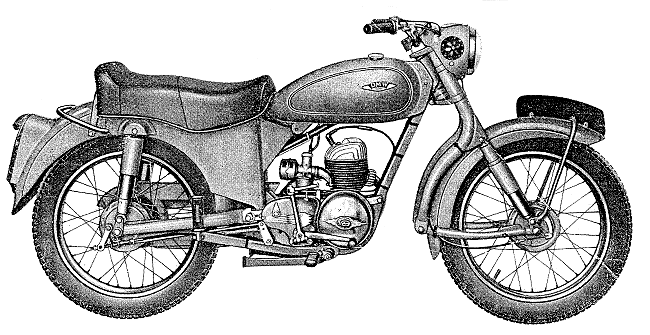
DMW 250 cc Mark 10 Competition Model.
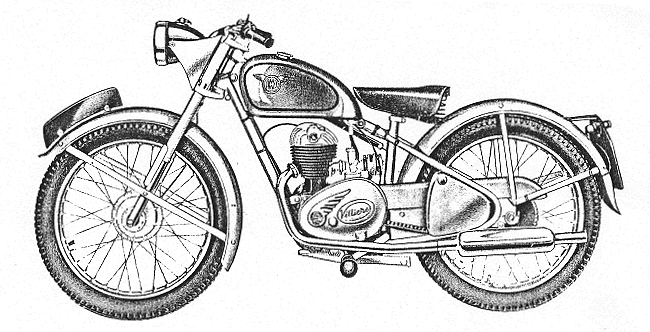
DMW 125 cc Model 125.
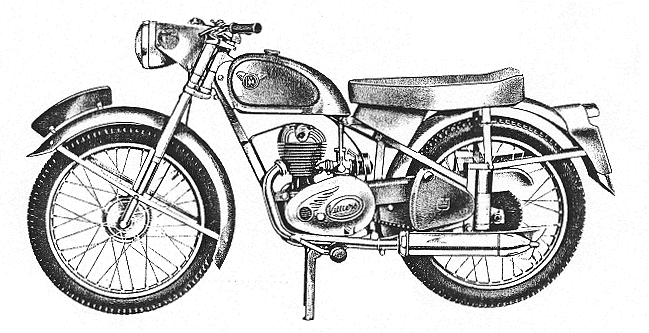
DMW 125 cc Model 200 Competition version.

DMW 125 cc Model 200 De Luxe.
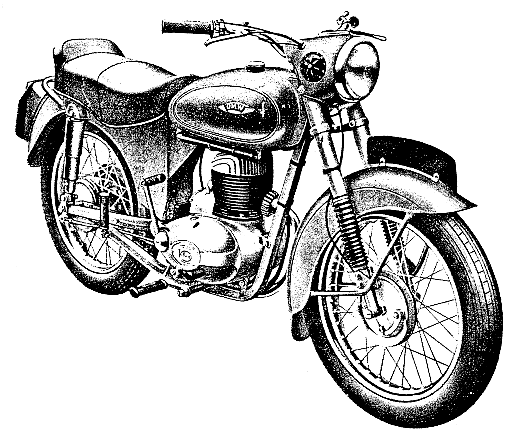
DMW 225 cc Cortina.
 |
|
 |
|
 |
Return to
Famous Machines |
|
Return to
the beginning |
|
Proceed to
The Later Years |
|